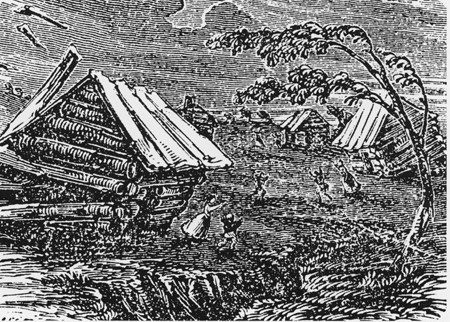The Great Earthquake at New Madrid, a 19th-century woodcut from Devens' Our First Century (1877)
The 1811–12 New Madrid earthquakes were an intense intraplate earthquake series beginning with an initial earthquake of moment magnitude
7.5–7.9 on December 16, 1811, followed by a moment magnitude 7.4
aftershock on the same day. They remain the most powerful earthquakes to
hit the contiguous United States east of the Rocky Mountains in recorded history. They, as well as the seismic zone of their occurrence, were named for the Mississippi River town of New Madrid, then part of the Louisiana Territory, now within Missouri.
There are estimates that these stable continental region earthquakes
were felt strongly over roughly 130,000 square kilometers
(50,000 sq mi), and moderately across nearly 3 million square kilometers. The 1906 San Francisco earthquake, by comparison, was felt moderately over roughly 16,000 km2.
The three earthquakes and their major aftershocks
- December 16, 1811, 0815 UTC (2:15 a.m.); (M 7.2 – 8.2) epicenter in northeast Arkansas. It caused only slight damage to manmade structures, mainly because of the sparse population in the epicentral area. The future location of Memphis, Tennessee, experienced level IX shaking on the Mercalli intensity scale. A seismic seiche propagated upriver, and Little Prairie (a village that was on the site of the former Fort San Fernando, near the site of present-day Caruthersville, Missouri) was heavily damaged by soil liquefaction.
- December 16, 1811 (aftershock), the Daylight Shock, 1415 UTC (8:15 a.m.); (M 7.2 – 8.2) epicenter in northeast Arkansas. This shock followed the first earthquake by five hours and was similar in intensity.
- January 23, 1812, 1500 UTC (9:00 a.m.); (M 7.0 – 8.0) epicenter in the Missouri Bootheel. The meizoseismal area was characterized by general ground warping, ejections, fissuring, severe landslides, and caving of stream banks. Johnson and Schweig attributed this earthquake to a rupture on the New Madrid North Fault. This may have placed strain on the Reelfoot Fault.
- February 7, 1812, 0945 UTC (3:45 a.m.); (M 7.4 – 8.6) epicenter near New Madrid, Missouri. New Madrid was destroyed. In St. Louis, Missouri, many houses were severely damaged, and their chimneys were toppled. This shock was definitively attributed to the Reelfoot Fault by Johnston and Schweig. Uplift along a segment of this reverse fault created temporary waterfalls on the Mississippi at Kentucky Bend, created waves that propagated upstream, and caused the formation of Reelfoot Lake by obstructing streams in what is now Lake County, Tennessee.[3]
Susan Hough, a seismologist of the United States Geological Survey (USGS), has estimated the earthquakes' magnitudes as around magnitude 7.
There were many more aftershocks, including one magnitude 7
aftershock to the December 16, 1811 earthquake which occurred at 0600
UTC (12:00 a.m.) on December 17, 1811, and one magnitude 7 aftershock to
the February 7, 1812 earthquake which occurred on the same day at 0440
UTC (10:40 p.m.).
New Madrid fault and earthquake-prone region considered at high risk today
in Wikipédia





Sem comentários:
Enviar um comentário